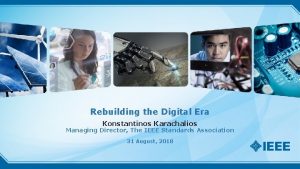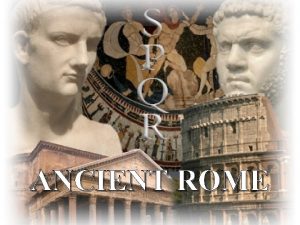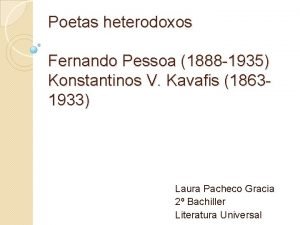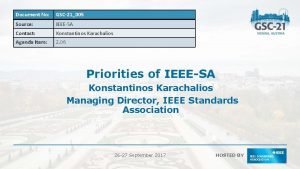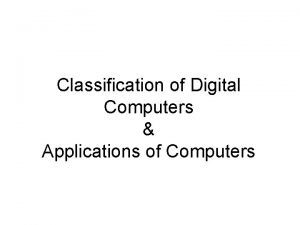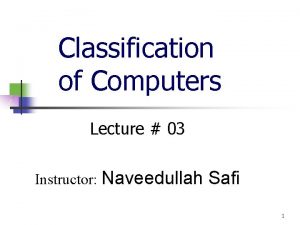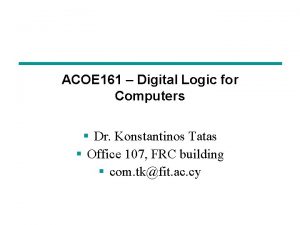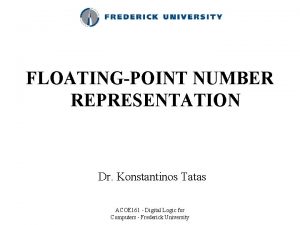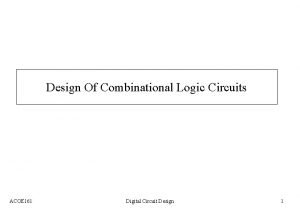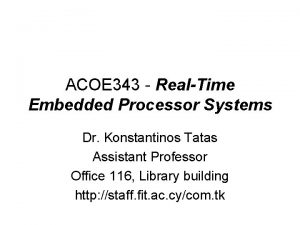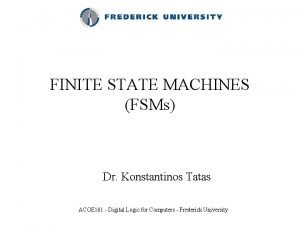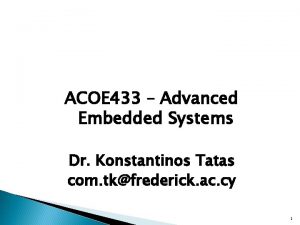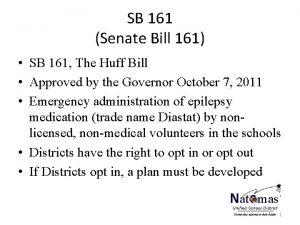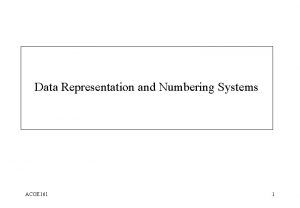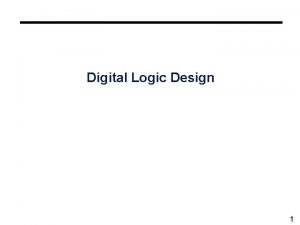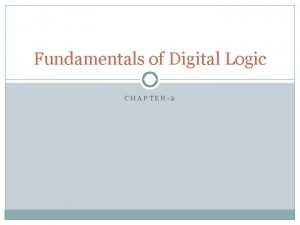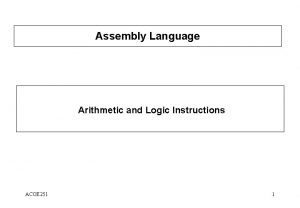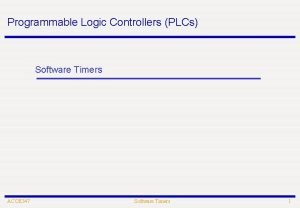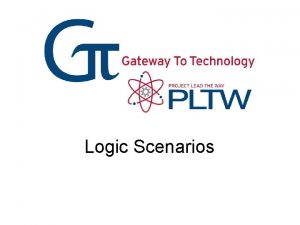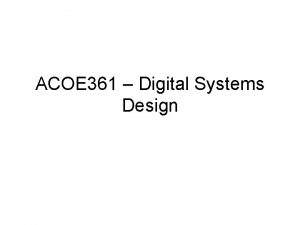ACOE 161 Digital Logic for Computers Dr Konstantinos

















- Slides: 17

ACOE 161 – Digital Logic for Computers Dr. Konstantinos Tatas

General Information • Instructors: K. Tatas, S. Savva – com. tk@frederick. ac. cy – Library Building Office 116 • ECTS: 7 (approx. 175 h) • 3 hours/week Lectures • 2 hours/week Labs 2

Learning Outcomes • Explain how and why information is coded and manipulated in a variety of different ways. • Apply Boolean algebra, Karnaugh maps and algorithmic minimization techniques to analyze and design combinational digital circuits. • Use latches and flip flops to design and analyze synchronous and asynchronous sequential digital circuits such as counters and registers. • Employ EDA tools and programmable logic devices for the design and implementation of digital circuits. • Simulate, build and test combinational and sequential logic circuits using TTL ICs and programmable logic devices 3 such as FPGAs.

Course Outline (1/2) • Number systems and codes: Introduction to computer numbering systems: Binary number representation. Conversion from decimal to any base and from any base to decimal. BCD representation. Fractional and negative number representation: Sign-magnitude, radix – 1 and radix complement representation. Addition and subtraction using radix complement. Excess and floating-point number representations • Combinational circuits: Basic digital components, truth tables and logic functions Karnaugh maps and algorithmic minimization techniques. Circuit implementation of logic functions. Design of combinational MSI digital circuits such as decoders, encoders, adders/subtracters, multiplexers, comparators etc. 4

Course Outline (2/2) • Sequential circuits: Latches and Set/Reset, Data, JK and Toggle flip-flops. Positive and negative edge triggered flip flops. Asynchronous flip-flop inputs. Asynchronous counters, synchronous counters and shift registers. • Programmable Logic Devices: PLAs, PALs, CPLDs and FPGAs. Programming of FPGAs using schematic diagrams. Use of computer programs to design and simulate digital circuits. • Laboratory Exercises: Individual and small group experiments including simulation of digital circuits and implementation using TTL ICs. 5

What is Digital (1/2) • A digital signal is a signal that can only have discrete values in time – Most common are binary digital signals, where only two values are allowed often designated as 0 and 1 • The opposite is analog signals that can take infinite values 6

What is Digital (2/2) • A digital system processes digital signals • Examples: computer, cellphone, DVD, digital camera, etc. 7

Okay, what is a signal then? • A signal is a physical quantity (sound, light, voltage, current) that carries information – The power cable supplies power but no information (not a signal) – A USB cable carries information (files) • Examples of quantities used as digital information signals – Voltage: 5 V (logic 1), 0 V (logic 0) in digital circuits – Magnetic field orientation in magnetic hard disks – Pits and lands on the CD surface reflect the light from the laser differently, and that difference is encoded as binary data 8

ANALOG VS DIGITAL • Analog devices and systems: Process analog signals (timevarying signals that can take any value across a continuous range known as dynamic range) • Digital devices and systems: Process digital signals (analog signals that are modeled as having at any time one of two discrete values) 9

Example of analog vs digital system Digital advantages: Battery life Programmability Accuracy 10

The world is analog • Few systems like the watch can be completely digital • Systems that interact with the environment, need to process analog information • How? Analog signals must first be converted to digital 11

Example of analog vs digital system Analog Digital Temperature sensor (analog) A/D Display converter 12

ANALOG GOES DIGITAL • • Photography Video Audio Automobile applications Telephony/Telecomunications Traffic lights Special effects 13

WHY DIGITAL? ADVANTAGES OF DIGITAL PROCESSING • • • Reproducibility of results Ease of design Programmability Speed Noise tolerance 14

DIGITAL ABSTRACTION 15

Example of using digital over analog: Telecommunications Noisy channel • Digital systems are less sensitive to noise • As long as 0 is distinguishable from 1 16

Binary Values: Other Physical Quantities • What are other physical quantities represent 0 and 1? – CPU Voltage – Disk Magnetic Field Direction – CD Surface Pits/Light – Dynamic RAM Electrical Charge – Quantum Computers – Single Electron Transistors Electron – Spintronics Electron Spin 17
 Konstantinos karachalios
Konstantinos karachalios Konstantinos argiros triplets
Konstantinos argiros triplets Teepc
Teepc Konstantinos
Konstantinos Konstantinos kavafis biografia
Konstantinos kavafis biografia Konstantinos karachalios
Konstantinos karachalios Publik sektor
Publik sektor Introduction to digital control
Introduction to digital control Classification of digital computers
Classification of digital computers Example of digital computers
Example of digital computers First order logic vs propositional logic
First order logic vs propositional logic First order logic vs propositional logic
First order logic vs propositional logic First order logic vs propositional logic
First order logic vs propositional logic Combinational logic vs sequential logic
Combinational logic vs sequential logic Cryptarithmetic problem logic+logic=prolog
Cryptarithmetic problem logic+logic=prolog Project management plan example
Project management plan example Combinational logic sequential logic
Combinational logic sequential logic Combinational logic sequential logic 차이
Combinational logic sequential logic 차이
